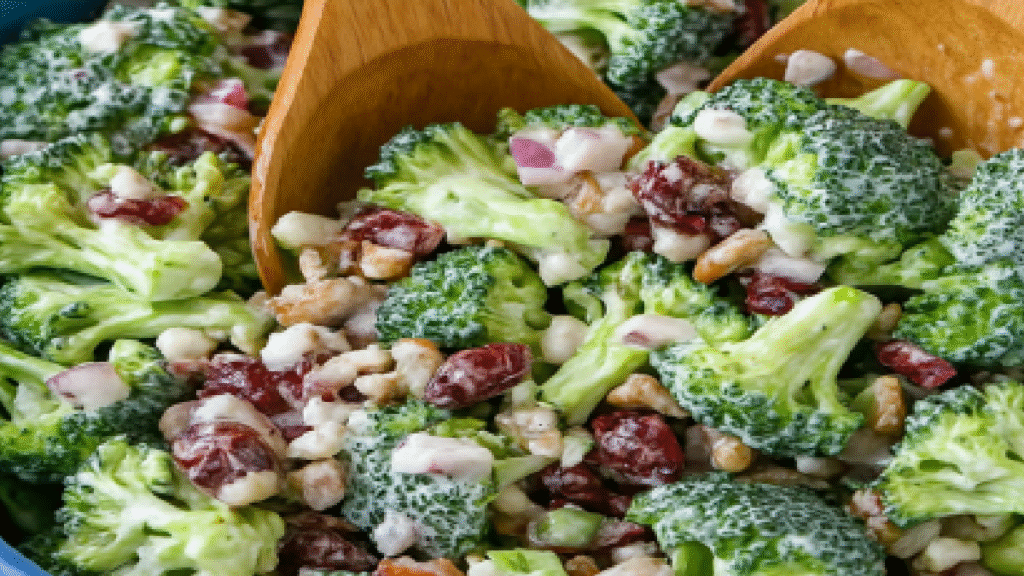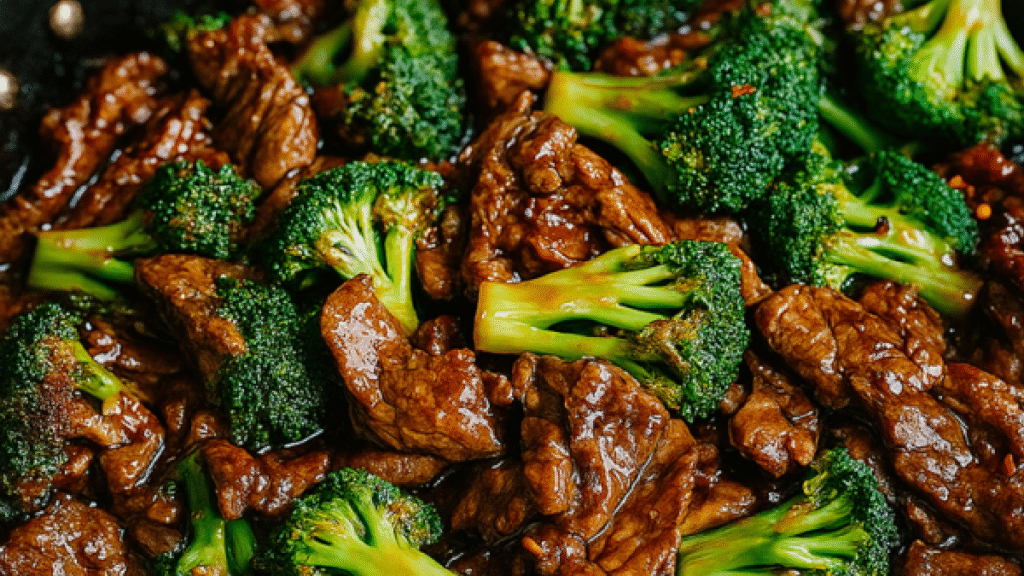Looking for a meal that’s both delicious and packed with nutrients? Broccoli Salad is an excellent choice. This dish is not only tasty but also offers numerous health benefits due to its high content of essential vitamins and minerals.
Broccoli is a nutrient-dense vegetable rich in fiber, vitamins, and minerals. It’s an excellent source of vitamin C, vitamin K, and folate, making it a healthy addition to any meal. By incorporating broccoli into a salad, you can create a nutritious meal option that’s perfect for any occasion.
Key Takeaways
- A nutritious meal option that’s rich in vitamins and minerals.
- Broccoli is an excellent source of vitamin C, vitamin K, and folate.
- A healthy broccoli salad is perfect for any meal or occasion.
- Packed with fiber, making it a great choice for digestive health.
- A delicious and healthy meal option for everyone.
The Nutritional Powerhouse of Broccoli Salad
Broccoli salad is a nutritional powerhouse, offering a delicious way to boost your overall health. This salad is not just a tasty side dish; it’s a rich source of essential vitamins, minerals, and other nutrients that contribute to overall well-being.
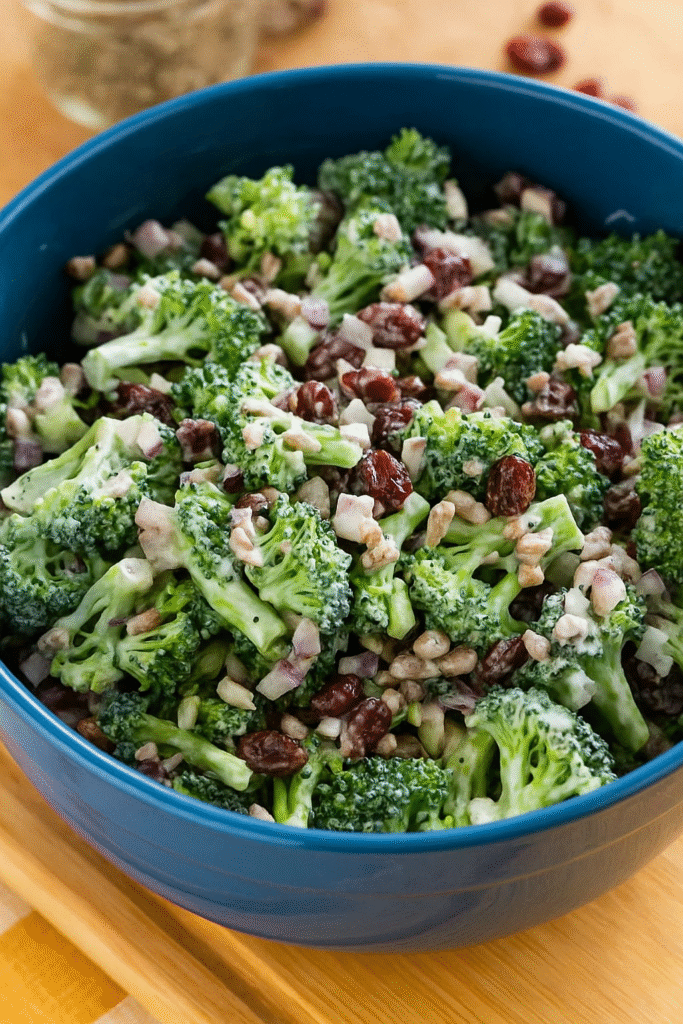
Essential Vitamins and Minerals
Broccoli salad is packed with vitamins and minerals that are crucial for maintaining good health. Some of the key nutrients include:
- Vitamin C: Important for immune function and collagen production.
- Calcium: Essential for bone health.
- Iron: Vital for healthy red blood cells.
Vitamin C and Antioxidant Content
Broccoli is an excellent source of vitamin C, a powerful antioxidant that helps protect cells from damage. Vitamin C also supports the immune system and aids in the production of collagen, which is important for healthy skin.
Calcium and Iron Benefits
In addition to vitamin C, broccoli salad is a good source of calcium and iron. Calcium is crucial for maintaining strong bones and teeth, while iron is essential for the production of healthy red blood cells.
Fiber Content and Digestive Benefits
Broccoli salad is also high in fiber, which is important for digestive health. A diet rich in fiber can help promote regular bowel movements and support the growth of beneficial gut bacteria.
- Promotes Regular Bowel Movements: Fiber helps move food through the digestive system.
- Supports Healthy Gut Bacteria: Fiber acts as a prebiotic, feeding the good bacteria in the gut.
Protein and Macronutrient Profile
While broccoli salad is not typically high in protein, it can be made more substantial with the addition of protein-rich ingredients like nuts, seeds, or cheese. The macronutrient profile can vary based on the ingredients used, but broccoli itself is low in calories and rich in complex carbohydrates.
History and Origins of Broccoli Salad
Tracing back the origins of broccoli salad leads us to the sun-kissed Mediterranean cuisine, where broccoli has been a staple for centuries. The Mediterranean diet, known for its health benefits and flavorful dishes, has played a significant role in shaping the evolution of broccoli salad.
Traditional Roots in Mediterranean Cuisine
The Mediterranean region is where broccoli originated, and it has been a crucial ingredient in various traditional dishes. The use of broccoli in salads, along with other vegetables, herbs, and healthy fats, reflects the Mediterranean dietary patterns that emphasize freshness and simplicity.
Broccoli’s versatility and nutritional value made it a favorite among Mediterranean cooks, who incorporated it into numerous recipes, from simple salads to complex main courses.
Evolution into Modern Recipes
As culinary practices evolved, so did the recipes for broccoli salad. Modern variations have incorporated a wide range of ingredients, from nuts and seeds to various cheeses and dressings, making broccoli salad a diverse and dynamic dish.
The adaptability of broccoli salad to different tastes and dietary preferences has contributed to its popularity worldwide.
Broccoli’s Journey to French Cuisine
Broccoli’s introduction to French cuisine marked a significant milestone in its culinary journey. French chefs, known for their culinary expertise, adopted broccoli and integrated it into their repertoire, creating sophisticated salads that highlighted its flavor and texture.
The incorporation of broccoli into French salads not only enriched French cuisine but also underscored the vegetable’s global appeal and culinary versatility.
Essential Ingredients for a Perfect Broccoli Salad
Crafting the perfect broccoli salad begins with selecting the finest ingredients. A great broccoli salad is more than just a mix of vegetables; it’s a harmonious blend of flavors, textures, and nutrients.
Selecting the Best Broccoli
The foundation of a great broccoli salad is, of course, the broccoli itself. When it comes to choosing broccoli, there are several factors to consider.
Seasonal Varieties Available in France
France offers a range of broccoli varieties throughout the year. In the cooler months, you can find the robust Calabrese broccoli, while the warmer months bring the tender Broccolini. Choosing seasonal broccoli ensures the best flavor and texture.
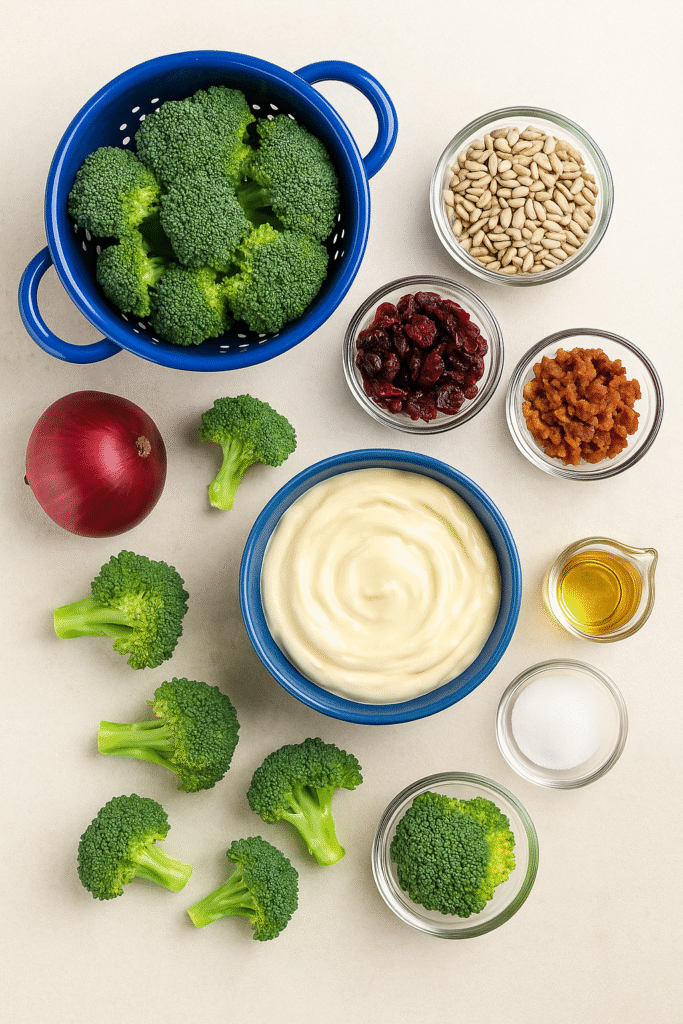
Organic vs. Conventional Options
The debate between organic and conventional broccoli is ongoing. While organic options may offer lower pesticide residues, conventional broccoli is often more affordable and still packed with nutrients. The choice ultimately depends on personal preference and budget.
Complementary Vegetables and Add-ins
Beyond broccoli, a variety of complementary vegetables and add-ins can elevate your salad. Some popular choices include:
- Crunchy carrots for a sweet contrast
- Diced apples for a refreshing twist
- Toasted nuts or seeds for added crunch
- Dried cranberries for a tangy flavor
For inspiration, you can explore other salad recipes like the Quinoa Salad, which incorporates a variety of vegetables and nuts.
Dressing Components and Alternatives
The dressing is what brings all the ingredients together, adding moisture, flavor, and a touch of creativity to your broccoli salad. Traditional dressings often include a mix of mayonnaise, vinegar, and mustard. However, there are numerous alternatives, such as:
- Vinaigrette for a lighter taste
- Yogurt-based dressings for a creamy, healthier option
- Avocado-based dressings for a rich, vegan-friendly choice
Experimenting with different dressing components can help you find the perfect balance for your taste buds.
Classic Broccoli Salad Recipe
Discover the simplicity of a classic broccoli salad recipe that’s perfect for any meal. This salad is not only delicious but also packed with nutrients, making it a great addition to your meal repertoire.
Ingredient List and Measurements
To make this classic broccoli salad, you’ll need the following ingredients:
- 2 cups of fresh broccoli florets
- 1 cup of cherry tomatoes, halved
- 1/2 cup of red onion, thinly sliced
- 1/4 cup of crumbled feta cheese
- 1/4 cup of chopped walnuts
- 2 tablespoons of olive oil
- 1 tablespoon of apple cider vinegar
- Salt and pepper to taste
For variations, you can also consider adding other ingredients like cooked chicken or bacon for added protein, similar to the Chinese beef and broccoli recipe.
Step-by-Step Preparation Guide
Preparing this broccoli salad is straightforward. Follow these steps:
- In a large bowl, combine the broccoli florets, cherry tomatoes, and red onion.
- In a small bowl, whisk together the olive oil and apple cider vinegar to make the dressing.
- Pour the dressing over the broccoli mixture and toss to coat.
- Sprinkle the crumbled feta cheese and chopped walnuts over the top.
- Season with salt and pepper to taste.
- Serve immediately, or refrigerate for up to 2 hours before serving.
Chef’s Tips for Perfect Results
To ensure your broccoli salad turns out perfectly, consider the following tips:
- Use fresh ingredients: Fresh broccoli and cherry tomatoes will make a big difference in the flavor and texture.
- Don’t overdress: Add the dressing just before serving to keep the salad crisp.
- Customize to taste: Feel free to adjust the ingredients based on your preferences or dietary needs.
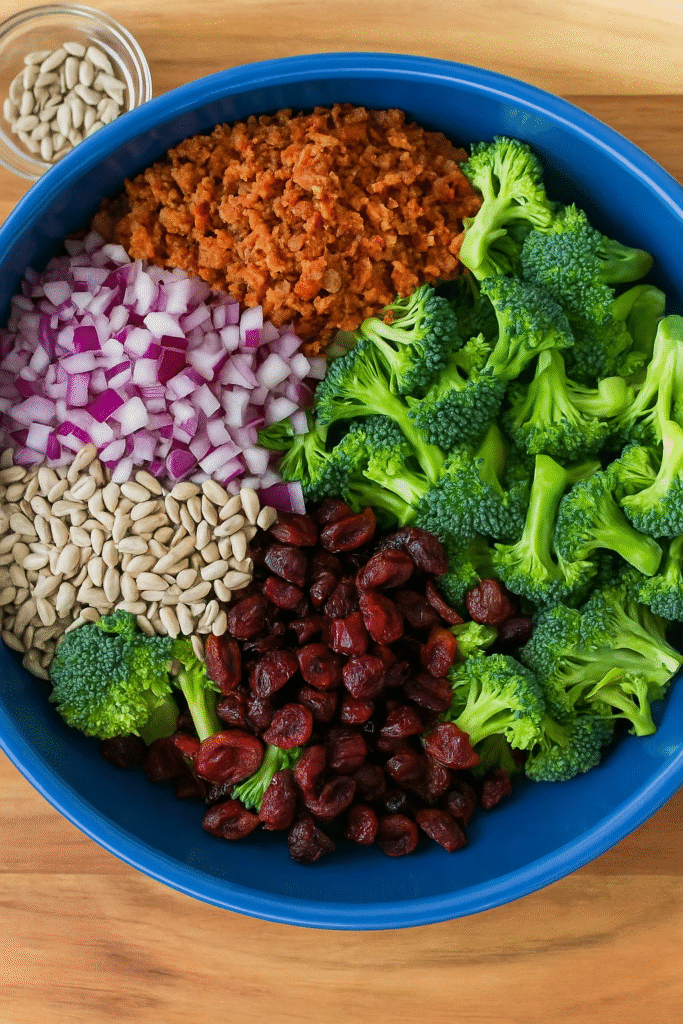
The Art of Preparing Broccoli Salad
To create a truly exceptional broccoli salad, one must master the art of preparation, from blanching to marination. The process involves several key decisions that can elevate the dish from simple to sublime.
Blanching vs. Raw Preparation Methods
The debate between blanching and using raw broccoli is ongoing. Blanching involves briefly submerging the broccoli in boiling water to preserve its color and texture, while raw preparation retains the vegetable’s crunch and nutrients. Both methods have their merits.
- Blanching helps to reduce bitterness and makes the broccoli more tender.
- Raw broccoli retains more vitamins and has a crunchier texture.
The choice between blanching and raw preparation depends on personal preference and the desired texture of the salad.
Cutting and Chopping Techniques
The way broccoli is cut and chopped can significantly impact the salad’s overall texture and appearance. Uniform cutting ensures that each bite has a balanced mix of ingredients. Here are some tips for effective cutting and chopping:
- Use a sharp knife to prevent bruising the broccoli.
- Cut the broccoli into florets of similar size for even distribution.
- Consider chopping some ingredients finely to add depth to the salad.
Marination and Flavor Development
Marination is a crucial step in developing the flavors of the broccoli salad. Allowing the ingredients to marinate can enhance the overall taste and texture. A good marination process involves:
- Using a balanced dressing that complements the broccoli.
- Allowing the salad to marinate for at least 30 minutes.
- Tasting and adjusting the seasoning before serving.
By mastering these aspects of broccoli salad preparation, you can create a dish that is not only delicious but also visually appealing.
Creative Variations of Broccoli Salad
The versatility of broccoli salad allows for a myriad of creative variations, making it a dish that can be reinvented according to taste preferences and culinary traditions.
Mediterranean-Inspired Version
A Mediterranean-inspired broccoli salad can be created by incorporating ingredients such as feta cheese, Kalamata olives, and sun-dried tomatoes. The addition of fresh oregano and a lemon-tahini dressing enhances the Mediterranean flavors. This version is not only delicious but also packed with nutrients.
Key ingredients: Feta cheese, Kalamata olives, sun-dried tomatoes, fresh oregano, lemon-tahini dressing.
Asian Fusion Broccoli Salad
For an Asian fusion twist, broccoli salad can be made with ingredients like soy sauce, ginger, and sesame seeds. Adding sliced almonds or cashews provides a crunchy texture, while a dressing made with rice vinegar and honey adds a sweet and sour taste.
Notable additions: Soy sauce, ginger, sesame seeds, sliced almonds, rice vinegar, honey.
French Provincial Adaptations
French provincial adaptations of broccoli salad offer a rich culinary experience. Two notable variations include the Normandy style and the Provençal version.
Normandy Style with Apple and Camembert
The Normandy style incorporates crisp apples and Camembert cheese, giving the salad a creamy and refreshing flavor profile. A light vinaigrette dressing complements the ingredients without overpowering them.
“The combination of broccoli with apples and Camembert is a testament to the versatility of French cuisine.”
Provençal Version with Herbs and Olives
The Provençal version is characterized by the use of herbs such as thyme and rosemary, along with olives and a garlic-infused dressing. This gives the salad a robust and aromatic flavor, reminiscent of the Provençal region.
These creative variations demonstrate how broccoli salad can be adapted to different culinary traditions, offering a range of flavors and textures to suit any palate.
Serving Suggestions and Food Pairings
Elevate your dining experience with broccoli salad, a versatile dish that pairs well with a variety of main courses and beverages. Whether you’re planning a casual meal or a sophisticated dinner party, broccoli salad can be a delightful addition to your menu.
Main Dish Accompaniments
Broccoli salad complements a range of main dishes, from grilled meats to vegetarian options. It pairs particularly well with grilled chicken or fish, offering a refreshing contrast to the richness of the protein. For a vegetarian meal, consider serving it alongside quiche Lorraine or a hearty vegetable tart. The salad’s crunchy texture and tangy dressing can also cut through the richness of dishes like salade mechouia, a spicy Tunisian salad.
French Wine and Beverage Pairings
When it comes to wine pairings, broccoli salad’s fresh flavors make it a great match for crisp, dry whites. A Sancerre or Picpoul de Pinet can complement the salad’s herbal notes, while a dry Rosé can add a refreshing touch to your meal. For those who prefer non-alcoholic beverages, a glass of fresh lemonade or infused water with citrus or mint can cleanse the palate between bites.
Presentation Ideas for Special Occasions
For special occasions, the presentation of broccoli salad can be just as important as its taste. Consider serving it in a hollowed-out bell pepper or a glass jar for a colorful and elegant display. Garnishing with edible flowers or microgreens can add a touch of sophistication. To make it a centerpiece, arrange the salad on a large platter and surround it with crudités or toasted bread for a visually appealing and inviting spread.
Storage Tips and Meal Prep Strategies
The key to a consistently delicious broccoli salad lies in effective meal prep and storage strategies. Proper handling ensures that the salad remains fresh and flavorful for a longer period. In this section, we’ll explore the best practices for storing broccoli salad, preparing it ahead of time, and even reviving leftovers.
Keeping Your Broccoli Salad Fresh
To keep your broccoli salad fresh, it’s crucial to store it in an airtight container in the refrigerator. The dressing can make the salad soggy over time, so consider storing it separately and combining just before serving. This simple step can significantly extend the salad’s freshness.
Tips for maintaining freshness:
- Use fresh, crisp ingredients.
- Avoid overdressing the salad before storage.
- Keep the salad refrigerated at a consistent temperature below 40°F (4°C).
Make-Ahead Techniques for Busy Schedules
Preparing broccoli salad ahead of time can be a game-changer for busy schedules. Chop the vegetables and prepare the dressing a day in advance. Store them separately in airtight containers and combine just before serving. This technique not only saves time but also helps in maintaining the texture and flavor of the salad.
Make-ahead tips:
- Prepare the salad components separately.
- Store in airtight containers.
- Combine and dress just before serving.
Reviving Day-Old Broccoli Salad
If your broccoli salad has been sitting in the fridge for a day, it can often be revived with a simple refresh. Add a squeeze of fresh lemon juice, a sprinkle of salt, or a bit more of your favorite dressing to rejuvenate the flavors. This quick fix can make day-old broccoli salad taste almost as good as freshly made.
Seasonal Adaptations for Year-Round Enjoyment
Incorporating seasonal produce into broccoli salad not only enhances its flavor but also its nutritional value. This approach allows for a diverse and exciting culinary experience throughout the year. As the seasons change, so do the ingredients available, offering a wide range of possibilities for broccoli salad variations.
Spring and Summer Variations
During spring and summer, fresh herbs like parsley and basil can be added to broccoli salad, providing a bright and refreshing flavor. Cherry tomatoes and carrots are also at their peak during these seasons, adding natural sweetness and crunch to the salad. For a lighter dressing, consider using a lemon-tahini or a simple olive oil and vinegar mixture.
As summer progresses, ingredients like grilled chicken or shrimp can be incorporated to make the salad more substantial. The key is to balance the flavors and textures, ensuring that the broccoli remains the star ingredient.
Fall and Winter Adjustments
In fall and winter, the focus shifts to heartier ingredients that complement the earthy sweetness of broccoli. Dried cranberries and nuts can add a pleasant contrast in texture, while a tangy apple cider vinegar dressing can enhance the overall flavor profile. Roasted butternut squash or sweet potatoes can also be mixed in, adding warmth and depth to the salad.
For a French twist, consider incorporating duck confit or bacon into your fall or winter broccoli salad, providing a rich and satisfying element.
Incorporating French Seasonal Produce
France is renowned for its seasonal produce, and incorporating these ingredients can elevate broccoli salad to new heights. In the spring, fresh peas and asparagus can be added, while in the summer, bell peppers and zucchini make excellent additions. During the fall, ingredients like pumpkin and walnuts can be incorporated, and in winter, roasted root vegetables add warmth and comfort.
By embracing the seasonal produce available in France, you can create a variety of broccoli salads that are not only delicious but also reflective of the country’s rich culinary heritage.
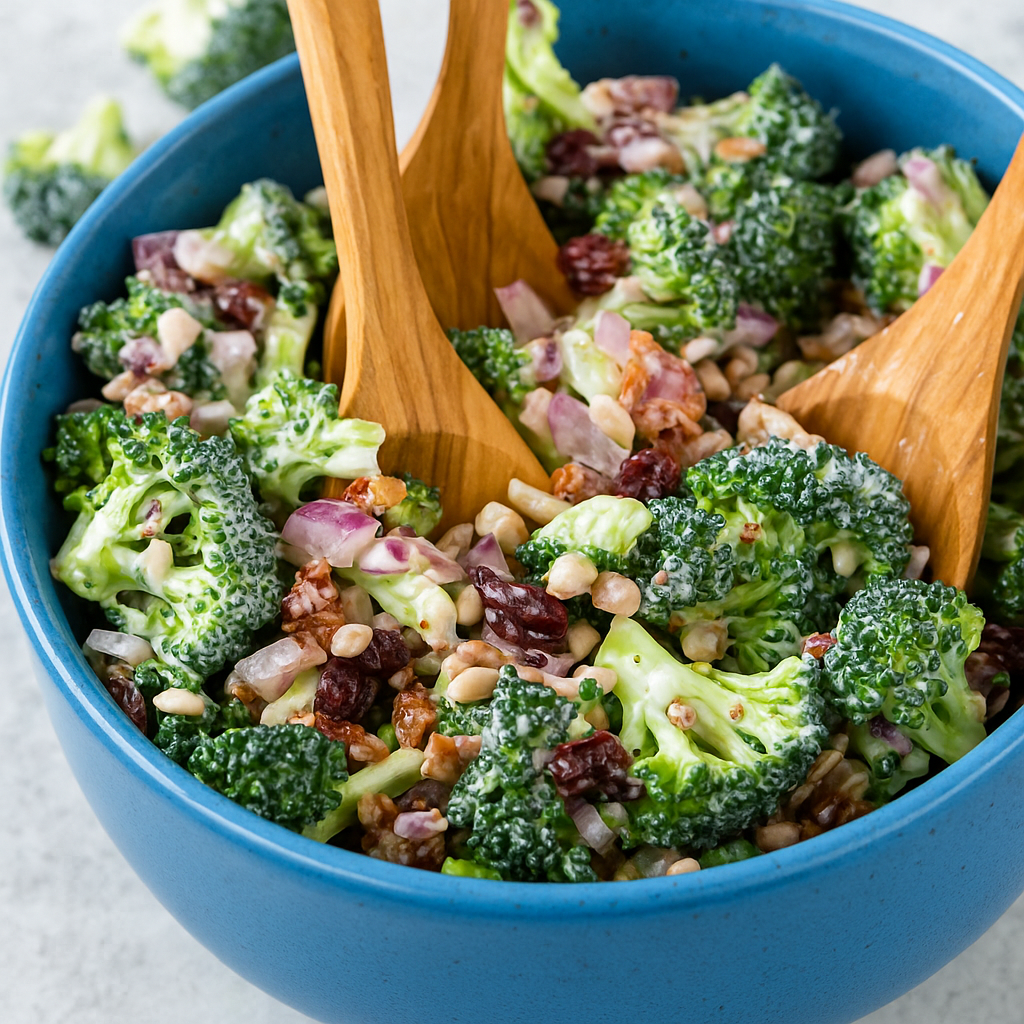
Health Benefits of Making Broccoli Salad a Regular Meal Option
Regular consumption of broccoli salad can lead to significant improvements in overall health. Broccoli salad is rich in essential nutrients, including vitamins, minerals, and antioxidants that contribute to its numerous health benefits.
Weight Management and Satiety
Broccoli salad is an excellent choice for those looking to manage their weight. The high fiber content in broccoli helps promote feelings of fullness and satiety, reducing the likelihood of overeating. Additionally, the protein and healthy fats found in many broccoli salad recipes further contribute to a feeling of satisfaction, making it easier to stick to a weight management plan. For more insights on preparing vegetables like broccoli, you can check out this guide on cooking Brussels sprouts, which shares valuable tips on vegetable preparation.
Anti-inflammatory Properties
The anti-inflammatory properties of broccoli salad are another significant health benefit. Broccoli contains a wealth of antioxidants and anti-inflammatory compounds, such as sulforaphane, which have been shown to help reduce inflammation in the body. Chronic inflammation is associated with various health conditions, including arthritis, diabetes, and cardiovascular disease. By incorporating broccoli salad into your diet, you can help mitigate these risks and promote overall well-being.
Immune System Support
Broccoli salad also plays a crucial role in supporting the immune system. The high content of vitamin C in broccoli helps boost the immune system by enhancing the production of white blood cells, which are vital for fighting off infections. Furthermore, other nutrients present in broccoli, such as vitamin K and fiber, contribute to a healthy gut microbiome, which is essential for a robust immune response.
In conclusion, making broccoli salad a regular part of your meal plan can have a profound impact on your health, from aiding in weight management and reducing inflammation to supporting your immune system. With its rich nutritional profile and versatility in recipes, broccoli salad is an excellent addition to a healthy and balanced diet.
Broccoli Cultivation in France
Broccoli cultivation is a significant agricultural activity in various regions of France. The country’s diverse climate and rich soil provide ideal conditions for growing this nutritious vegetable. France’s broccoli cultivation not only caters to its domestic demand but also contributes to its culinary heritage.
Regional Growing Practices
The regional growing practices in France play a crucial role in the quality and yield of broccoli. Different regions have adopted unique farming techniques tailored to their specific climate and soil conditions.
Brittany’s Broccoli Production
Brittany is one of the leading broccoli-producing regions in France. Its mild oceanic climate and fertile soil make it an ideal location for broccoli cultivation. The region’s farmers employ sustainable farming practices, ensuring high-quality produce.
Other Notable Growing Regions
Apart from Brittany, other regions such as Loire Valley and Normandy are also known for their broccoli production. Each region brings its own expertise and techniques to broccoli farming, contributing to the country’s overall yield.
Seasonal Availability and Local Markets
Broccoli is available throughout the year in France, but its peak season varies by region. Understanding the seasonal availability is crucial for consumers who prefer to buy fresh, locally grown produce from local markets. These markets not only offer the freshest broccoli but also support the local economy.
Supporting Local French Farmers
Supporting local farmers is essential for the sustainability of broccoli cultivation in France. By buying directly from local markets or through farm-to-table programs, consumers can contribute to the local agricultural economy and enjoy fresher, more flavorful broccoli.
Common Mistakes to Avoid When Making Broccoli Salad
The key to a delicious broccoli salad lies in avoiding the pitfalls that many home cooks fall into. While it may seem like a simple dish to prepare, there are several common mistakes that can turn a potentially great salad into a disappointing one.
Overcooking Issues and Solutions
One of the most common mistakes is overcooking the broccoli. Overcooking can make the broccoli mushy and unappetizing. To avoid this, it’s essential to blanch the broccoli correctly. Blanching involves briefly submerging the broccoli in boiling water and then immediately plunging it into an ice bath to stop the cooking process. For more on proper food handling techniques, you can check out this article on food storage tips.
As Julia Child once said, “The only time to eat diet food is while you’re waiting for the steak to cook.” This quote emphasizes the importance of enjoying your food, including broccoli salad, when it’s prepared correctly.
Dressing and Seasoning Errors
Another mistake is using too much or too little dressing. The dressing should complement the broccoli without overpowering it. A good rule of thumb is to start with a small amount of dressing and add more to taste. Also, be mindful of the seasoning; a pinch of salt and a sprinkle of herbs can make a big difference.
Ingredient Balance Problems
Finally, achieving the right balance of ingredients is crucial. Too many ingredients can make the salad confusing, while too few can make it boring. A balanced broccoli salad typically includes a mix of textures and flavors, such as crunchy nuts, sweet dried fruits, and tangy cheese.
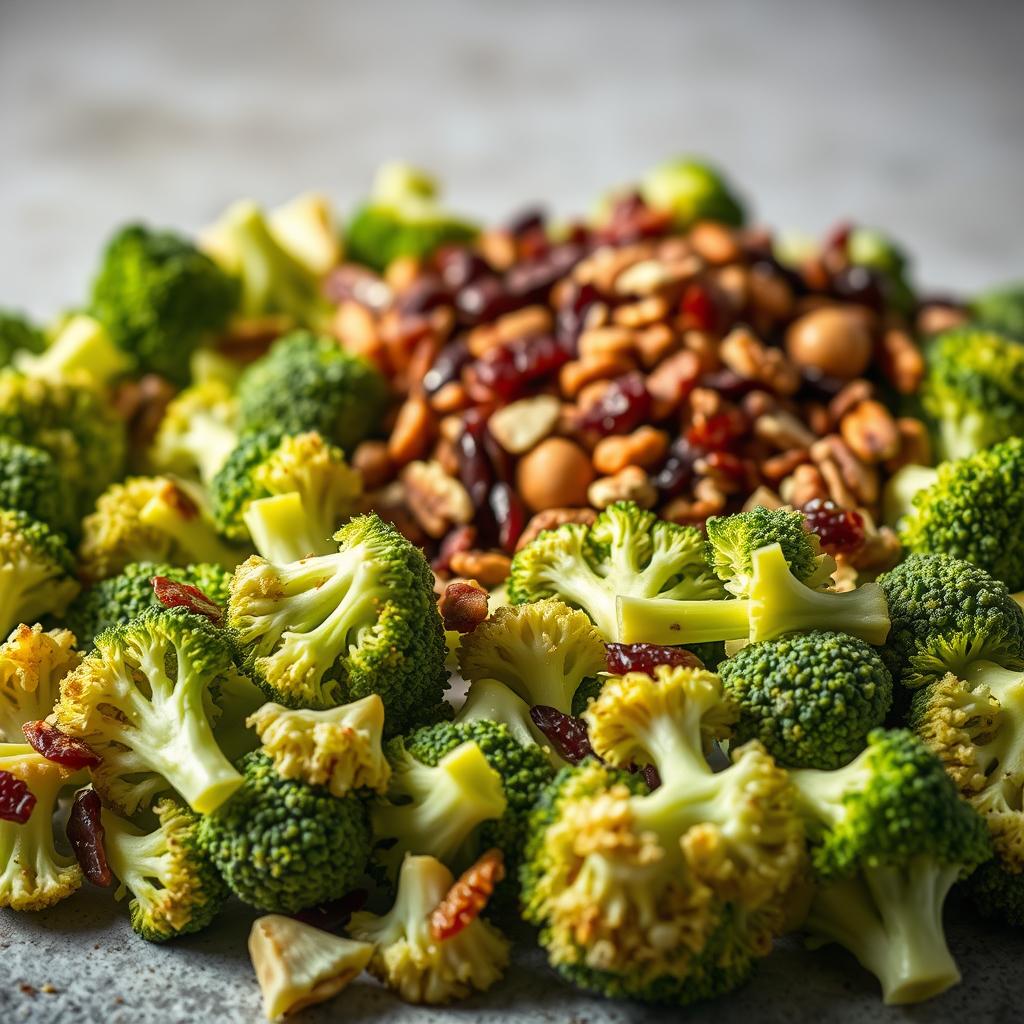
By avoiding these common mistakes, you can create a broccoli salad that is not only delicious but also visually appealing. Remember, the key is to keep the broccoli fresh, balance the flavors, and dress it just right.
Conclusion
In conclusion, broccoli salad is a versatile and healthy meal option that can be tailored to suit various tastes and dietary preferences.
This nutritious dish is packed with essential vitamins, minerals, and fiber, making it an excellent addition to a balanced diet. Whether you’re looking for a quick snack or a satisfying main course, broccoli salad is an excellent choice.
By experimenting with different ingredients and recipes, you can create a unique broccoli salad that suits your taste buds. So, don’t be afraid to get creative and make broccoli salad a regular part of your meal routine.
FAQ
What are the health benefits of broccoli salad?
Broccoli salad is rich in essential vitamins and minerals, fiber, and protein, making it a nutritious meal option that supports overall health and well-being, aids in weight management, and provides anti-inflammatory properties.
How do I select the best broccoli for my salad?
To select the best broccoli, look for seasonal varieties available in France, and consider the pros and cons of organic vs. conventional options. Choose fresh, firm, and vibrant broccoli for the best flavor and texture.
Can I make broccoli salad ahead of time?
Yes, broccoli salad can be made ahead of time. Use make-ahead techniques such as preparing the ingredients separately and storing them in airtight containers to keep the salad fresh.
How do I prevent overcooking broccoli in my salad?
To prevent overcooking, use blanching or raw preparation methods. Blanching helps preserve the color and texture of broccoli, while raw preparation retains its crunchiness.
What are some creative variations of broccoli salad?
Try Mediterranean-inspired, Asian fusion, or French provincial adaptations by incorporating different flavors and ingredients, such as olives, nuts, or citrus vinaigrette, to create unique and delicious variations.
How do I store broccoli salad to keep it fresh?
Store broccoli salad in an airtight container in the refrigerator, and keep it away from strong-smelling foods. Revive day-old broccoli salad by adding a refreshing dressing or topping.
Can broccoli salad be a main dish?
Yes, broccoli salad can be a satisfying main dish when paired with complementary ingredients, such as grilled chicken or salmon, and served with crusty bread or crackers.
How does broccoli salad support immune function?
Broccoli salad is rich in vitamins C and K, and other essential nutrients that support immune function and overall health, making it a great addition to a healthy diet.
What are some common mistakes to avoid when making broccoli salad?
Avoid overcooking broccoli, using too much dressing, or adding too many ingredients, which can make the salad soggy or unbalanced. Balance flavors and textures to create a delicious and refreshing salad.
Can I use frozen broccoli for broccoli salad?
While frozen broccoli can be used in some recipes, it’s not recommended for broccoli salad, as it may be too soft or mushy. Fresh broccoli is preferred for its crunchy texture and flavor.Looking for a meal that’s both delicious and packed with nutrients? Broccoli Salad is an excellent choice. This dish is not only tasty but also offers numerous health benefits due to its high content of essential vitamins and minerals.
Broccoli is a nutrient-dense vegetable rich in fiber, vitamins, and minerals. It’s an excellent source of vitamin C, vitamin K, and folate, making it a healthy addition to any meal. By incorporating broccoli into a salad, you can create a nutritious meal option that’s perfect for any occasion.
Key Takeaways
- A nutritious meal option that’s rich in vitamins and minerals.
- Broccoli is an excellent source of vitamin C, vitamin K, and folate.
- A healthy broccoli salad is perfect for any meal or occasion.
- Packed with fiber, making it a great choice for digestive health.
- A delicious and healthy meal option for everyone.
The Nutritional Powerhouse of Broccoli Salad
Broccoli salad is a nutritional powerhouse, offering a delicious way to boost your overall health. This salad is not just a tasty side dish; it’s a rich source of essential vitamins, minerals, and other nutrients that contribute to overall well-being.
Essential Vitamins and Minerals
Broccoli salad is packed with vitamins and minerals that are crucial for maintaining good health. Some of the key nutrients include:
- Vitamin C: Important for immune function and collagen production.
- Calcium: Essential for bone health.
- Iron: Vital for healthy red blood cells.
Vitamin C and Antioxidant Content
Broccoli is an excellent source of vitamin C, a powerful antioxidant that helps protect cells from damage. Vitamin C also supports the immune system and aids in the production of collagen, which is important for healthy skin.
Calcium and Iron Benefits
In addition to vitamin C, broccoli salad is a good source of calcium and iron. Calcium is crucial for maintaining strong bones and teeth, while iron is essential for the production of healthy red blood cells.
Fiber Content and Digestive Benefits
Broccoli salad is also high in fiber, which is important for digestive health. A diet rich in fiber can help promote regular bowel movements and support the growth of beneficial gut bacteria.
- Promotes Regular Bowel Movements: Fiber helps move food through the digestive system.
- Supports Healthy Gut Bacteria: Fiber acts as a prebiotic, feeding the good bacteria in the gut.
Protein and Macronutrient Profile
While broccoli salad is not typically high in protein, it can be made more substantial with the addition of protein-rich ingredients like nuts, seeds, or cheese. The macronutrient profile can vary based on the ingredients used, but broccoli itself is low in calories and rich in complex carbohydrates.
History and Origins of Broccoli Salad
Tracing back the origins of broccoli salad leads us to the sun-kissed Mediterranean cuisine, where broccoli has been a staple for centuries. The Mediterranean diet, known for its health benefits and flavorful dishes, has played a significant role in shaping the evolution of broccoli salad.
Traditional Roots in Mediterranean Cuisine
The Mediterranean region is where broccoli originated, and it has been a crucial ingredient in various traditional dishes. The use of broccoli in salads, along with other vegetables, herbs, and healthy fats, reflects the Mediterranean dietary patterns that emphasize freshness and simplicity.
Broccoli’s versatility and nutritional value made it a favorite among Mediterranean cooks, who incorporated it into numerous recipes, from simple salads to complex main courses.
Evolution into Modern Recipes
As culinary practices evolved, so did the recipes for broccoli salad. Modern variations have incorporated a wide range of ingredients, from nuts and seeds to various cheeses and dressings, making broccoli salad a diverse and dynamic dish.
The adaptability of broccoli salad to different tastes and dietary preferences has contributed to its popularity worldwide.
Broccoli’s Journey to French Cuisine
Broccoli’s introduction to French cuisine marked a significant milestone in its culinary journey. French chefs, known for their culinary expertise, adopted broccoli and integrated it into their repertoire, creating sophisticated salads that highlighted its flavor and texture.
The incorporation of broccoli into French salads not only enriched French cuisine but also underscored the vegetable’s global appeal and culinary versatility.
Essential Ingredients for a Perfect Broccoli Salad
Crafting the perfect broccoli salad begins with selecting the finest ingredients. A great broccoli salad is more than just a mix of vegetables; it’s a harmonious blend of flavors, textures, and nutrients.
Selecting the Best Broccoli
The foundation of a great broccoli salad is, of course, the broccoli itself. When it comes to choosing broccoli, there are several factors to consider.
Seasonal Varieties Available in France
France offers a range of broccoli varieties throughout the year. In the cooler months, you can find the robust Calabrese broccoli, while the warmer months bring the tender Broccolini. Choosing seasonal broccoli ensures the best flavor and texture.
Organic vs. Conventional Options
The debate between organic and conventional broccoli is ongoing. While organic options may offer lower pesticide residues, conventional broccoli is often more affordable and still packed with nutrients. The choice ultimately depends on personal preference and budget.
Complementary Vegetables and Add-ins
Beyond broccoli, a variety of complementary vegetables and add-ins can elevate your salad. Some popular choices include:
- Crunchy carrots for a sweet contrast
- Diced apples for a refreshing twist
- Toasted nuts or seeds for added crunch
- Dried cranberries for a tangy flavor
For inspiration, you can explore other salad recipes like the Quinoa Salad, which incorporates a variety of vegetables and nuts.
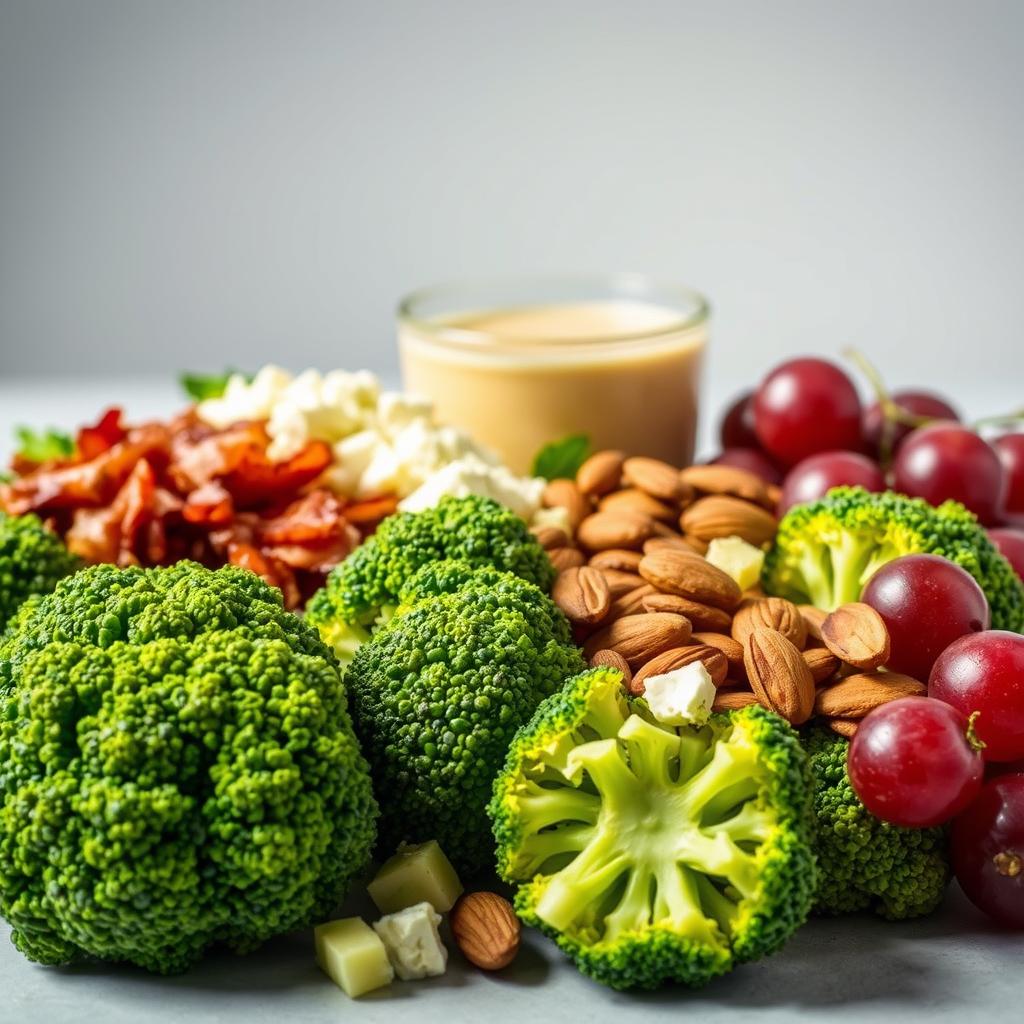
Dressing Components and Alternatives
The dressing is what brings all the ingredients together, adding moisture, flavor, and a touch of creativity to your broccoli salad. Traditional dressings often include a mix of mayonnaise, vinegar, and mustard. However, there are numerous alternatives, such as:
- Vinaigrette for a lighter taste
- Yogurt-based dressings for a creamy, healthier option
- Avocado-based dressings for a rich, vegan-friendly choice
Experimenting with different dressing components can help you find the perfect balance for your taste buds.
Classic Broccoli Salad Recipe
Discover the simplicity of a classic broccoli salad recipe that’s perfect for any meal. This salad is not only delicious but also packed with nutrients, making it a great addition to your meal repertoire.
Ingredient List and Measurements
To make this classic broccoli salad, you’ll need the following ingredients:
- 2 cups of fresh broccoli florets
- 1 cup of cherry tomatoes, halved
- 1/2 cup of red onion, thinly sliced
- 1/4 cup of crumbled feta cheese
- 1/4 cup of chopped walnuts
- 2 tablespoons of olive oil
- 1 tablespoon of apple cider vinegar
- Salt and pepper to taste
For variations, you can also consider adding other ingredients like cooked chicken or bacon for added protein, similar to the Chinese beef and broccoli recipe.
Step-by-Step Preparation Guide
Preparing this broccoli salad is straightforward. Follow these steps:
- In a large bowl, combine the broccoli florets, cherry tomatoes, and red onion.
- In a small bowl, whisk together the olive oil and apple cider vinegar to make the dressing.
- Pour the dressing over the broccoli mixture and toss to coat.
- Sprinkle the crumbled feta cheese and chopped walnuts over the top.
- Season with salt and pepper to taste.
- Serve immediately, or refrigerate for up to 2 hours before serving.
Chef’s Tips for Perfect Results
To ensure your broccoli salad turns out perfectly, consider the following tips:
- Use fresh ingredients: Fresh broccoli and cherry tomatoes will make a big difference in the flavor and texture.
- Don’t overdress: Add the dressing just before serving to keep the salad crisp.
- Customize to taste: Feel free to adjust the ingredients based on your preferences or dietary needs.
The Art of Preparing Broccoli Salad
To create a truly exceptional broccoli salad, one must master the art of preparation, from blanching to marination. The process involves several key decisions that can elevate the dish from simple to sublime.
Blanching vs. Raw Preparation Methods
The debate between blanching and using raw broccoli is ongoing. Blanching involves briefly submerging the broccoli in boiling water to preserve its color and texture, while raw preparation retains the vegetable’s crunch and nutrients. Both methods have their merits.
- Blanching helps to reduce bitterness and makes the broccoli more tender.
- Raw broccoli retains more vitamins and has a crunchier texture.
The choice between blanching and raw preparation depends on personal preference and the desired texture of the salad.
Cutting and Chopping Techniques
The way broccoli is cut and chopped can significantly impact the salad’s overall texture and appearance. Uniform cutting ensures that each bite has a balanced mix of ingredients. Here are some tips for effective cutting and chopping:
- Use a sharp knife to prevent bruising the broccoli.
- Cut the broccoli into florets of similar size for even distribution.
- Consider chopping some ingredients finely to add depth to the salad.
Marination and Flavor Development
Marination is a crucial step in developing the flavors of the broccoli salad. Allowing the ingredients to marinate can enhance the overall taste and texture. A good marination process involves:
- Using a balanced dressing that complements the broccoli.
- Allowing the salad to marinate for at least 30 minutes.
- Tasting and adjusting the seasoning before serving.
By mastering these aspects of broccoli salad preparation, you can create a dish that is not only delicious but also visually appealing.
Creative Variations of Broccoli Salad
The versatility of broccoli salad allows for a myriad of creative variations, making it a dish that can be reinvented according to taste preferences and culinary traditions.
Mediterranean-Inspired Version
A Mediterranean-inspired broccoli salad can be created by incorporating ingredients such as feta cheese, Kalamata olives, and sun-dried tomatoes. The addition of fresh oregano and a lemon-tahini dressing enhances the Mediterranean flavors. This version is not only delicious but also packed with nutrients.
Key ingredients: Feta cheese, Kalamata olives, sun-dried tomatoes, fresh oregano, lemon-tahini dressing.
Asian Fusion Broccoli Salad
For an Asian fusion twist, broccoli salad can be made with ingredients like soy sauce, ginger, and sesame seeds. Adding sliced almonds or cashews provides a crunchy texture, while a dressing made with rice vinegar and honey adds a sweet and sour taste.
Notable additions: Soy sauce, ginger, sesame seeds, sliced almonds, rice vinegar, honey.
French Provincial Adaptations
French provincial adaptations of broccoli salad offer a rich culinary experience. Two notable variations include the Normandy style and the Provençal version.
Normandy Style with Apple and Camembert
The Normandy style incorporates crisp apples and Camembert cheese, giving the salad a creamy and refreshing flavor profile. A light vinaigrette dressing complements the ingredients without overpowering them.
“The combination of broccoli with apples and Camembert is a testament to the versatility of French cuisine.”
Provençal Version with Herbs and Olives
The Provençal version is characterized by the use of herbs such as thyme and rosemary, along with olives and a garlic-infused dressing. This gives the salad a robust and aromatic flavor, reminiscent of the Provençal region.
These creative variations demonstrate how broccoli salad can be adapted to different culinary traditions, offering a range of flavors and textures to suit any palate.
Serving Suggestions and Food Pairings
Elevate your dining experience with broccoli salad, a versatile dish that pairs well with a variety of main courses and beverages. Whether you’re planning a casual meal or a sophisticated dinner party, broccoli salad can be a delightful addition to your menu.
Main Dish Accompaniments
Broccoli salad complements a range of main dishes, from grilled meats to vegetarian options. It pairs particularly well with grilled chicken or fish, offering a refreshing contrast to the richness of the protein. For a vegetarian meal, consider serving it alongside quiche Lorraine or a hearty vegetable tart. The salad’s crunchy texture and tangy dressing can also cut through the richness of dishes like salade mechouia, a spicy Tunisian salad.
French Wine and Beverage Pairings
When it comes to wine pairings, broccoli salad’s fresh flavors make it a great match for crisp, dry whites. A Sancerre or Picpoul de Pinet can complement the salad’s herbal notes, while a dry Rosé can add a refreshing touch to your meal. For those who prefer non-alcoholic beverages, a glass of fresh lemonade or infused water with citrus or mint can cleanse the palate between bites.
Presentation Ideas for Special Occasions
For special occasions, the presentation of broccoli salad can be just as important as its taste. Consider serving it in a hollowed-out bell pepper or a glass jar for a colorful and elegant display. Garnishing with edible flowers or microgreens can add a touch of sophistication. To make it a centerpiece, arrange the salad on a large platter and surround it with crudités or toasted bread for a visually appealing and inviting spread.
Storage Tips and Meal Prep Strategies
The key to a consistently delicious broccoli salad lies in effective meal prep and storage strategies. Proper handling ensures that the salad remains fresh and flavorful for a longer period. In this section, we’ll explore the best practices for storing broccoli salad, preparing it ahead of time, and even reviving leftovers.
Keeping Your Broccoli Salad Fresh
To keep your broccoli salad fresh, it’s crucial to store it in an airtight container in the refrigerator. The dressing can make the salad soggy over time, so consider storing it separately and combining just before serving. This simple step can significantly extend the salad’s freshness.
Tips for maintaining freshness:
- Use fresh, crisp ingredients.
- Avoid overdressing the salad before storage.
- Keep the salad refrigerated at a consistent temperature below 40°F (4°C).
Make-Ahead Techniques for Busy Schedules
Preparing broccoli salad ahead of time can be a game-changer for busy schedules. Chop the vegetables and prepare the dressing a day in advance. Store them separately in airtight containers and combine just before serving. This technique not only saves time but also helps in maintaining the texture and flavor of the salad.
Make-ahead tips:
- Prepare the salad components separately.
- Store in airtight containers.
- Combine and dress just before serving.
Reviving Day-Old Broccoli Salad
If your broccoli salad has been sitting in the fridge for a day, it can often be revived with a simple refresh. Add a squeeze of fresh lemon juice, a sprinkle of salt, or a bit more of your favorite dressing to rejuvenate the flavors. This quick fix can make day-old broccoli salad taste almost as good as freshly made.
Seasonal Adaptations for Year-Round Enjoyment
Incorporating seasonal produce into broccoli salad not only enhances its flavor but also its nutritional value. This approach allows for a diverse and exciting culinary experience throughout the year. As the seasons change, so do the ingredients available, offering a wide range of possibilities for broccoli salad variations.
Spring and Summer Variations
During spring and summer, fresh herbs like parsley and basil can be added to broccoli salad, providing a bright and refreshing flavor. Cherry tomatoes and carrots are also at their peak during these seasons, adding natural sweetness and crunch to the salad. For a lighter dressing, consider using a lemon-tahini or a simple olive oil and vinegar mixture.
As summer progresses, ingredients like grilled chicken or shrimp can be incorporated to make the salad more substantial. The key is to balance the flavors and textures, ensuring that the broccoli remains the star ingredient.
Fall and Winter Adjustments
In fall and winter, the focus shifts to heartier ingredients that complement the earthy sweetness of broccoli. Dried cranberries and nuts can add a pleasant contrast in texture, while a tangy apple cider vinegar dressing can enhance the overall flavor profile. Roasted butternut squash or sweet potatoes can also be mixed in, adding warmth and depth to the salad.
For a French twist, consider incorporating duck confit or bacon into your fall or winter broccoli salad, providing a rich and satisfying element.
Incorporating French Seasonal Produce
France is renowned for its seasonal produce, and incorporating these ingredients can elevate broccoli salad to new heights. In the spring, fresh peas and asparagus can be added, while in the summer, bell peppers and zucchini make excellent additions. During the fall, ingredients like pumpkin and walnuts can be incorporated, and in winter, roasted root vegetables add warmth and comfort.
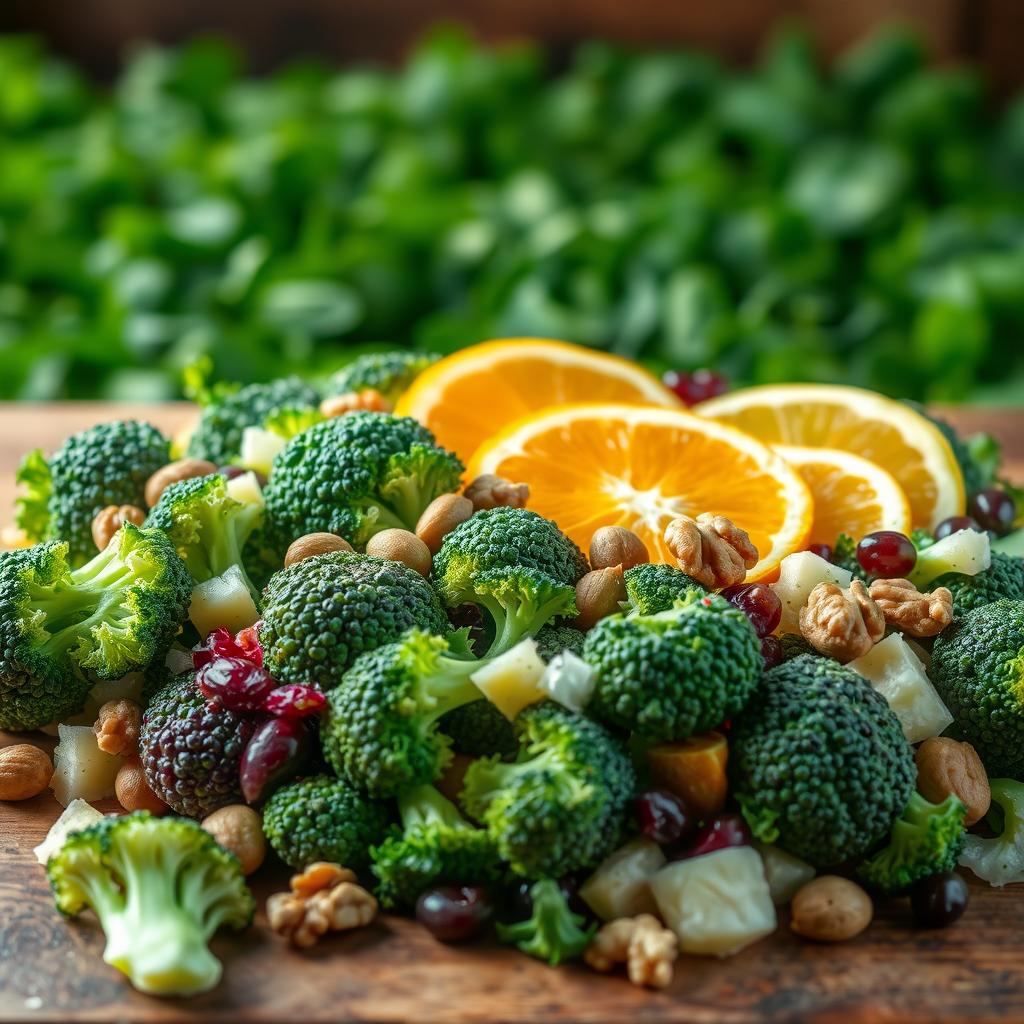
By embracing the seasonal produce available in France, you can create a variety of broccoli salads that are not only delicious but also reflective of the country’s rich culinary heritage.
Health Benefits of Making Broccoli Salad a Regular Meal Option
Regular consumption of broccoli salad can lead to significant improvements in overall health. Broccoli salad is rich in essential nutrients, including vitamins, minerals, and antioxidants that contribute to its numerous health benefits.
Weight Management and Satiety
Broccoli salad is an excellent choice for those looking to manage their weight. The high fiber content in broccoli helps promote feelings of fullness and satiety, reducing the likelihood of overeating. Additionally, the protein and healthy fats found in many broccoli salad recipes further contribute to a feeling of satisfaction, making it easier to stick to a weight management plan. For more insights on preparing vegetables like broccoli, you can check out this guide on cooking Brussels sprouts, which shares valuable tips on vegetable preparation.
Anti-inflammatory Properties
The anti-inflammatory properties of broccoli salad are another significant health benefit. Broccoli contains a wealth of antioxidants and anti-inflammatory compounds, such as sulforaphane, which have been shown to help reduce inflammation in the body. Chronic inflammation is associated with various health conditions, including arthritis, diabetes, and cardiovascular disease. By incorporating broccoli salad into your diet, you can help mitigate these risks and promote overall well-being.
Immune System Support
Broccoli salad also plays a crucial role in supporting the immune system. The high content of vitamin C in broccoli helps boost the immune system by enhancing the production of white blood cells, which are vital for fighting off infections. Furthermore, other nutrients present in broccoli, such as vitamin K and fiber, contribute to a healthy gut microbiome, which is essential for a robust immune response.
In conclusion, making broccoli salad a regular part of your meal plan can have a profound impact on your health, from aiding in weight management and reducing inflammation to supporting your immune system. With its rich nutritional profile and versatility in recipes, broccoli salad is an excellent addition to a healthy and balanced diet.
Broccoli Cultivation in France
Broccoli cultivation is a significant agricultural activity in various regions of France. The country’s diverse climate and rich soil provide ideal conditions for growing this nutritious vegetable. France’s broccoli cultivation not only caters to its domestic demand but also contributes to its culinary heritage.
Regional Growing Practices
The regional growing practices in France play a crucial role in the quality and yield of broccoli. Different regions have adopted unique farming techniques tailored to their specific climate and soil conditions.
Brittany’s Broccoli Production
Brittany is one of the leading broccoli-producing regions in France. Its mild oceanic climate and fertile soil make it an ideal location for broccoli cultivation. The region’s farmers employ sustainable farming practices, ensuring high-quality produce.
Other Notable Growing Regions
Apart from Brittany, other regions such as Loire Valley and Normandy are also known for their broccoli production. Each region brings its own expertise and techniques to broccoli farming, contributing to the country’s overall yield.
Seasonal Availability and Local Markets
Broccoli is available throughout the year in France, but its peak season varies by region. Understanding the seasonal availability is crucial for consumers who prefer to buy fresh, locally grown produce from local markets. These markets not only offer the freshest broccoli but also support the local economy.
Supporting Local French Farmers
Supporting local farmers is essential for the sustainability of broccoli cultivation in France. By buying directly from local markets or through farm-to-table programs, consumers can contribute to the local agricultural economy and enjoy fresher, more flavorful broccoli.
Common Mistakes to Avoid When Making Broccoli Salad
The key to a delicious broccoli salad lies in avoiding the pitfalls that many home cooks fall into. While it may seem like a simple dish to prepare, there are several common mistakes that can turn a potentially great salad into a disappointing one.
Overcooking Issues and Solutions
One of the most common mistakes is overcooking the broccoli. Overcooking can make the broccoli mushy and unappetizing. To avoid this, it’s essential to blanch the broccoli correctly. Blanching involves briefly submerging the broccoli in boiling water and then immediately plunging it into an ice bath to stop the cooking process. For more on proper food handling techniques, you can check out this article on food storage tips.
As Julia Child once said, “The only time to eat diet food is while you’re waiting for the steak to cook.” This quote emphasizes the importance of enjoying your food, including broccoli salad, when it’s prepared correctly.
Dressing and Seasoning Errors
Another mistake is using too much or too little dressing. The dressing should complement the broccoli without overpowering it. A good rule of thumb is to start with a small amount of dressing and add more to taste. Also, be mindful of the seasoning; a pinch of salt and a sprinkle of herbs can make a big difference.
Ingredient Balance Problems
Finally, achieving the right balance of ingredients is crucial. Too many ingredients can make the salad confusing, while too few can make it boring. A balanced broccoli salad typically includes a mix of textures and flavors, such as crunchy nuts, sweet dried fruits, and tangy cheese.
By avoiding these common mistakes, you can create a broccoli salad that is not only delicious but also visually appealing. Remember, the key is to keep the broccoli fresh, balance the flavors, and dress it just right.
Conclusion
In conclusion, broccoli salad is a versatile and healthy meal option that can be tailored to suit various tastes and dietary preferences.
This nutritious dish is packed with essential vitamins, minerals, and fiber, making it an excellent addition to a balanced diet. Whether you’re looking for a quick snack or a satisfying main course, broccoli salad is an excellent choice.
By experimenting with different ingredients and recipes, you can create a unique broccoli salad that suits your taste buds. So, don’t be afraid to get creative and make broccoli salad a regular part of your meal routine.
FAQ
What are the health benefits of broccoli salad?
Broccoli salad is rich in essential vitamins and minerals, fiber, and protein, making it a nutritious meal option that supports overall health and well-being, aids in weight management, and provides anti-inflammatory properties.
How do I select the best broccoli for my salad?
To select the best broccoli, look for seasonal varieties available in France, and consider the pros and cons of organic vs. conventional options. Choose fresh, firm, and vibrant broccoli for the best flavor and texture.
Can I make broccoli salad ahead of time?
Yes, broccoli salad can be made ahead of time. Use make-ahead techniques such as preparing the ingredients separately and storing them in airtight containers to keep the salad fresh.
How do I prevent overcooking broccoli in my salad?
To prevent overcooking, use blanching or raw preparation methods. Blanching helps preserve the color and texture of broccoli, while raw preparation retains its crunchiness.
What are some creative variations of broccoli salad?
Try Mediterranean-inspired, Asian fusion, or French provincial adaptations by incorporating different flavors and ingredients, such as olives, nuts, or citrus vinaigrette, to create unique and delicious variations.
How do I store broccoli salad to keep it fresh?
Store broccoli salad in an airtight container in the refrigerator, and keep it away from strong-smelling foods. Revive day-old broccoli salad by adding a refreshing dressing or topping.
Can broccoli salad be a main dish?
Yes, broccoli salad can be a satisfying main dish when paired with complementary ingredients, such as grilled chicken or salmon, and served with crusty bread or crackers.
How does broccoli salad support immune function?
Broccoli salad is rich in vitamins C and K, and other essential nutrients that support immune function and overall health, making it a great addition to a healthy diet.
What are some common mistakes to avoid when making broccoli salad?
Avoid overcooking broccoli, using too much dressing, or adding too many ingredients, which can make the salad soggy or unbalanced. Balance flavors and textures to create a delicious and refreshing salad.
Can I use frozen broccoli for broccoli salad?
While frozen broccoli can be used in some recipes, it’s not recommended for broccoli salad, as it may be too soft or mushy. Fresh broccoli is preferred for its crunchy texture and flavor.
How do I incorporate French seasonal produce into broccoli salad?
Incorporate seasonal produce available in France, such as cherry tomatoes in summer or carrots in winter, to add flavor, texture, and variety to your broccoli salad.
How do I incorporate French seasonal produce into broccoli salad?
Incorporate seasonal produce available in France, such as cherry tomatoes in summer or carrots in winter, to add flavor, texture, and variety to your broccoli salad.
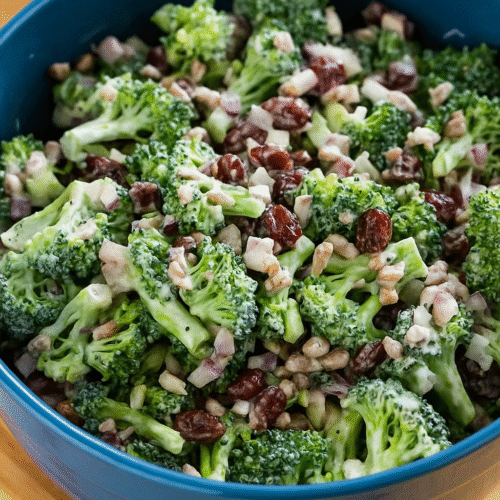
The Best Broccoli Salad
Ingredients
Salad:
- 8 cups broccoli florets cut into bite-sized pieces
- 1/3 cup diced red onion
- 1/2 cup dried cranberries
- 1/4 cup sunflower seeds
- 1/2 cup bacon bits
Dressing:
- 1 cup mayonnaise
- 3 tablespoons apple cider vinegar
- 2 tablespoons granulated sugar
- Salt and black pepper to taste
Instructions
- Make the dressing: In a medium bowl, whisk together mayonnaise, vinegar, sugar, salt, and pepper. Set aside.
- Combine ingredients: In a large bowl, mix broccoli, red onion, cranberries, sunflower seeds, and bacon bits.
- Add dressing: Pour dressing over the salad and toss well to combine.
- Chill: Refrigerate at least 1 hour before serving to allow flavors to develop.
Notes
Nutrition Information (per serving)
- Calories: 300
- Carbohydrates: 17g
- Protein: 6g
- Fat: 26g
- Saturated Fat: 4g
- Cholesterol: 18mg
- Sodium: 330mg
- Potassium: 365mg
- Fiber: 3g
- Sugar: 10g
- Vitamin C: 82mg

